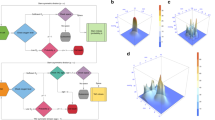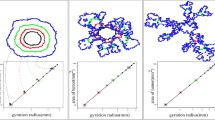Abstract
Recent findings indicate that in a hypoxic environment, oncogenically transformed cells with a mutant form of the tumour suppressor gene p53 may have a survival advantage over similar cells with wild-type p53. This is because the extent of hypoxia-induced apoptosis has been observed to diminish with the loss of wild-type p53 function in certain cell lines. Hypoxic conditions, common in most solid tumours, may thus provide a physiological pressure to select for cells with mutations in the p53 gene. A new model incorporating cell-specific parameters is proposed here to quantify the survival advantage of mutant or null p53 cells over their wild-type counterparts at any level of oxygen deprivation. Predictions are in good agreement with previous monolayer culture experiments comparing hypoxic survival of null and wild-type p53 cells. By extending the model we are able to investigate the effects of repeated rounds of hypoxia and reoxygenation on a mixture of wild-type and mutant or null p53 cells and determine how many rounds are required before a subpopulation of mutant or null p53 cells overtakes a given population of wild-type p53 cells.
Similar content being viewed by others
References
Amellem, Ø., T. Stokke, J. A. Sandvik, L. Smedshammer and E. O. Pettersen (1997). Hypoxia-induced apoptosis in human cells with normal p53 status and function, without any alteration in the nuclear protein level. Exp. Cell Res. 232, 361–370.
An, W. G., M. Kanekal, M. C. Simon, E. Maltepe, M. V. Blagosklonny and L. M. Neckers (1998). Stabilization of wild-type p53 by hypoxia-inducible factor 1α. Nature 392, 405–408.
Bristow, R. G., S. Benchimol and R. P. Hill (1996). The p53 gene as a modifier of intrinsic radiosensitivity: implications for radiotherapy. Radiother. Oncol. 40, 197–223.
Brown, J. M. (1979). Evidence for acutely hypoxic cells in mouse tumours, and a possible mechanism of reoxygenation. Br. J. Radiol. 52, 650–656.
Brown, J. M. and A. J. Giaccia (1998). The unique physiology of solid tumors: opportunities (and problems) for cancer therapy. Cancer Res. 58, 1408–1416.
Carmeliet, P., et al. (1997). Role of HIF-1α in hypoxia-mediated apoptosis, cell proliferation and tumour angiogenesis. Nature 394, 485–490.
Casciari, J. J., S. V. Sotirchos and R. M. Sutherland (1988). Glucose diffusivity in multicellular tumour spheroids. Cancer Res. 48, 3905–3909.
Casciari, J. J., S. V. Sotirchos and R. M. Sutherland (1992). Variations in tumor cell growth rates and metabolism with oxygen concentration, glucose concentration and extracellular pH. J. Cell. Physiol. 151, 386–394.
Chaplain, M. A. J. and N. F. Britton (1993). On the concentration profile of a growth inhibitory factor in multicell spheroids. Math. Biosci. 115, 233–245.
Clarke, A. R., C. A. Purdie, D. J. Harrison, R. G. Morris, C. C. Bird, M. L. Hooper and A. H. Wyllie (1993). Thymcyte apoptosis induced by p53-dependent and independent pathways. Nature 362, 849–852.
Dewhirst, M. W., C. Y. Tso, R. Oliver, C. S. Gustafson, T. W. Secomb and J. F. Gross (1989). Morphologic and hemodynamic comparison of tumor and healing normal tissue microvasculature. Int. J. Radiat. Oncol. Biol. Phys. 17, 91–99.
Fritsche, M., C. Haessler and G. Brandner (1993). Induction of nuclear accumulation of the tumour suppressor protein p53 by DNA-damaging agents. Oncogene 8, 307–318.
Graeber, T. G., C. Osmanian, T. Jacks, D. E. Housman, C. J. Koch, S. W. Lowe and A. J. Giaccia (1996). Hypoxia-mediated selection of cells with diminished apoptotic potential in solid tumours. Nature 379, 88–91.
Graeber, T. G., J. F. Peterson, T. Mitchell, K. Monica, A. J. Fornace, Jr. and A. J. Giaccia (1994). Hypoxia induces accumulation of p53 protein, but activation of a G1-phase checkpoint by low-oxygen conditions is independent of p53 status. Mol. Cell. Biol. 14, 6264–6277.
Greenblatt, M. S., W. P. Bennett, M. Hollstein and C. C. Harris (1994). Mutations in the p53 tumor suppressor gene: clues to cancer etiology and molecular pathogenesis. Cancer Res. 54, 4855–4878.
Greenspan, H. P. (1972). Models for the growth of a solid tumour by diffusion. Stud. Appl. Math. 52, 317–340.
Groebe, K. and W. Mueller-Klieser (1991). Distributions of oxygen, nutrient, and metabolic waste concentrations in multicellular spheroids and their dependence on spheroid parameters. Eur. Biophys. J. 19, 169–181.
Grunt, T. W., A. Lametschwandtner and O. Staindl (1985). The vascular pattern of basal cell tumors: light microscopy and scanning electron microscopic study on vascular corrosion casts. Microvas. Res. 29, 371–386.
Harris, C. C. and M. Hollstein (1993). Clinical implications of the p53 tumor-suppressor gene. New Engl. J. Med. 329, 1318–1327.
Helmlinger, G., F. Yuan, M. Dellian and R. K. Jain (1997). Interstitial pH and pO 2 gradients in solid tumors in vivo: high-resolution measurements reveal a lack of correlation. Nature Med. 3, 177–182.
Hollstein, M., D. Sidransky, B. Vogelstein and C. C. Harris (1991). p53 mutations in human cancers. Science 253, 49–53.
Kastan, M. B., O. Onyekwere, D. Sidransky, B. Vogelstein and R. W. Craig (1991). Participation of p53 protein in the cellular response to DNA damage. Cancer Res. 51, 6304–6311.
Kieser, A., H. A. Weich, G. Brandner, D. Marme and W. Kolch (1994). Mutant p53 potentiates protein kinase C induction of vascular endothelial growth factor expression. Oncogene 9, 963–969.
Kuerbitz, S. J., B. S. Plunkett, W. V. Walsh and M. B. Kastan (1992). Wild-type p53 is a cell cycle checkpoint determinant following irradiation. Proc. Natl. Acad. Sci. USA 89, 7491–7495.
Lane, D. P. (1992). p53, guardian of the genome. Nature 358, 15–16.
Levine, A. J., M. E. Perry, A. Chang, A. Silver, D. Dittmer, M. Wu and D. Welsh (1994). The 1993 Walter Hubert Lecture: The role of the p53 tumour-suppressor gene in tumorigenesis. Br. J. Cancer 69, 409–416.
Lowe, S. W. (October 1998). Personal communication.
Lowe, S. W., S. Bodis, A. McClatchey, L. Remington, H. E. Ruley, D. E. Fisher, D. E. Housman and T. Jacks (1994). p53 status and the efficacy of cancer therapy in vivo. Science 266, 807–810.
Lu, X. and D. P. Lane (1993). Differential induction of transcriptionally active p53 following UV or ionizing radiation: defects in chromosome instability syndromes? Cell 75, 765–778.
Maltzman, W. and L. Czyzyk (1984). UV irradiation stimulates levels of p53 cellular tumour antigen in nontransformed mouse cells. Mol. Cell. Biol. 4, 1689–1694.
Royds, J. A., S. K. Dower, E. E. Qwarnstrom and C. E. Lewis (1998). Response of tumour cells to hypoxia: role of p53 and NFkB. Mol. Pathol. 51, 55–61.
Sutherland, R. M. (1986). Importance of critical metabolites and cellular interactions in the biology of microregions of tumors. Cancer 58, 1668–1680.
Thomlinson, R. H. (1977). Hypoxia and tumours. J. Clin. Pathol. 30, 105–113.
Thomlinson, R. H. and L. H. Gray (1955). The histological structure of some human lung cancers and the possible implications for radiotherapy. Br. J. Cancer 9, 539–549.
Vaupel, P. W. and M. Höckel (1995). Oxygenation status of human tumors: A reappraisal usingcomputerized pO2 histography, in Tumour Oxygenation, New York: Gustav Fischer Verlag, pp. 219–231.
Vaupel, P., K. Schlenger, C. Knoop and M. Höckel (1991). Oxygenation of human tumors: evaluation of tissue oxygen distribution in breast cancers by computerized O2 tension measurements. Cancer Res. 51, 3316–3322.
Wang, T. and H. Wang (1996). p53, apoptosis and human cancers. J. Formosan Med. Assoc. 95, 509–523.
Zhan, Q., F. Carrier and A. J. Fornace Jr. (1993). Induction of cellular p53 activity by DNA-damaging agents and growth arrest. Mol. Cell. Biol. 13, 4242–4250.
Ziegler, A., A. S. Jonason, D. J. Leffell, J. A. Simon, H. W. Sharma, J. Kimmelman, L. Remington, T. Jacks and D. E. Brash (1994). Sunburn and p53 in the onset of skin cancer. Nature 372, 773–776.
Author information
Authors and Affiliations
Corresponding author
Rights and permissions
About this article
Cite this article
Thompson, K.E., Royds, J.A. Hypoxia and reoxygenation: A pressure for mutant p53 cell selection and tumour progression. Bull. Math. Biol. 61, 759–778 (1999). https://doi.org/10.1006/bulm.1999.0109
Received:
Accepted:
Issue Date:
DOI: https://doi.org/10.1006/bulm.1999.0109




